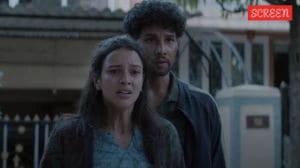Art Street: ‘Cutting Chai’ raises a toast to Mumbai city
Artist Sheetal Gattani's installation at a traffic island in Worli is a tribute to the beverage that Mumbai runs on
 Cutting Chai in Mumbai. (Express photo by Ganesh Shirsekar)
Cutting Chai in Mumbai. (Express photo by Ganesh Shirsekar)In February 2021, RPG Art Foundation approached artist Sheetal Gattani to make an installation that symbolised Mumbai. The brief was simple enough. “It was anything that speaks ‘Bombay’,” Gattani, 53, said.
Yet, she knew there were countless metaphors for Mumbai. For instance, RPG Art Foundation — businessman Harsh Goenka’s CSR programme that revitalises Mumbai’s public spaces — had already installed other Mumbai-themed works in public spaces, such as a dabbawalla sculpture and tetrapods. Gattani toyed with options, such as the ubiquitous ‘nimbu-mirchi’, that was more relatable to India as a whole than just Mumbai and the vada pav that didn’t seem to lend itself suitably for an art installation. Eventually, a clear winner emerged — the half-full, half-empty glasses of chai (tea) that has fuelled Mumbaikars over the decades.
At a traffic island in Worli near the old passport office, Gattani’s “Cutting Chai” stands tall at 10 feet, comprising two hands that seem to clink cutting chai glasses. Gattani said, “Cutting chai is so Bombay. It is like a leveller. At a tapri, one can see a carpenter and someone in a suit relishing a ‘chai’.”
Built of acrylic and stainless steel, ‘Cutting Chai’ was installed by RPG Art Foundation, in partnership with MCGM, in December 2021. The plaque states that it’s “An Ode to the City that Never Sleeps” and that “Mumbai’s Cutting Chai is akin to the City’s Lifeblood.”
 Gattani said, “People haven’t come to a gallery. It’s not even in a park. They are driving by. They literally have a second to see it.”
Gattani said, “People haven’t come to a gallery. It’s not even in a park. They are driving by. They literally have a second to see it.”
Notable for her abstract works, Gattani has conducted several solo and group shows. With Cutting Chai, she aimed for directness, given that it’s placed on a traffic island. She said, “People haven’t come to a gallery. It’s not even in a park. They are driving by. They literally have a second to see it.”
Within this seemingly obvious interpretation, Gattani has managed to sneak in layers of meaning. She took the idea of a “cutting” chai a step further. Both the glasses are sliced through, presented as vertical cross sections. “It’s on an island, so you see exactly the same visual on both sides,” she said.
The installation’s hands emerge from a stand that recalls the cutting ‘chai’ holders that were once commonly used across the city. Crafted from wire, the holders nestled tea glasses within and were a staple at railway stations and wayside shops. With the prolific use of plastic cups and flasks today, this caddy has fallen out of fashion and has become a designer novelty.
Gattani said, “The two colours I have used for the hands are the colours of the holder wires. They were often blue or green. You don’t see them much anymore.”












